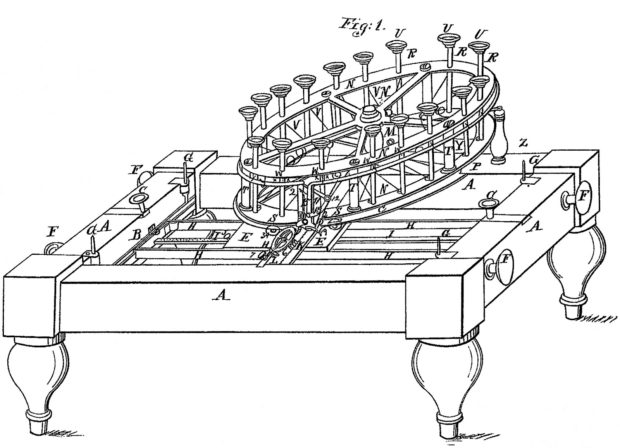James Thurber’s Typewriter
Not a lot of verifiable information is known about the early days of the typewriter. A lot wasn’t documented, especially about those who invented something that was never manufactured or died an early commercial death before Christopher Latham Sholes created an effective model and attracted the financing necessary to make it a success.
One example is James Thurber, an inventor and gun-maker. Thurber made his fortune with the Allen “Pocket Rifle” and a pocket pistol known as the “Pepperbox Allen.” According to the book The Marvels of Modern Mechanism, published in 1901, Thurber patented the first “practical typewriter” in 1843, although it was called a “mechanical chirographer” — later “Calligraph”–, was ungainly and slow and was never manufactured. (A museum in Worcester, Mass., has the only model in existence.) Even that turned out to be untrue when historians discovered that a backwoods tinkerer from Michigan, William Austin Burt, invented a machine he called a “typographer” and patented it in 1829.

However Thurber deserves credit for two innovations: the cylindrical paper carriage and the line shift when the typist returned the carriage, both features on manual and electric typewriters right up to the computer age.

To hear it from the inventor’s mouth (typed on his typewriter?), he was quoted from his patent documents in a report in the January 9, 1847 issue of Scientific American: “The nature of my invention consists in communicating to a pen or pencil holder, the motions necessary to delineate any and all letters or other characters, by motions at right angles to each other, obtained by sets of cams, each set being so formed as to combine the right angle movements, and thus generate the vertical, horizontal, oblique, and curved lines required to delineate the letters or characters. Each set of cams is actuated by a separate or distinct lever or handle, as in a piano forte, and the table, with the paper, &c., caused to move for ward the required distance at the termination of each letter or character by the return motion of the lever or handle.”


It’s interesting to remember that typewriters in the mid-to-late 18th century faced resistance. Aside from their value for use with the telegraph and for the blind, most people thought written correspondence needed to be personally hand-written in lovely cursive script, not banged out on a machine. Unable to see into the distant future, Thurber later worked on an ultimately unsuccessrul mechanical invention that would reproduce handwriting.
